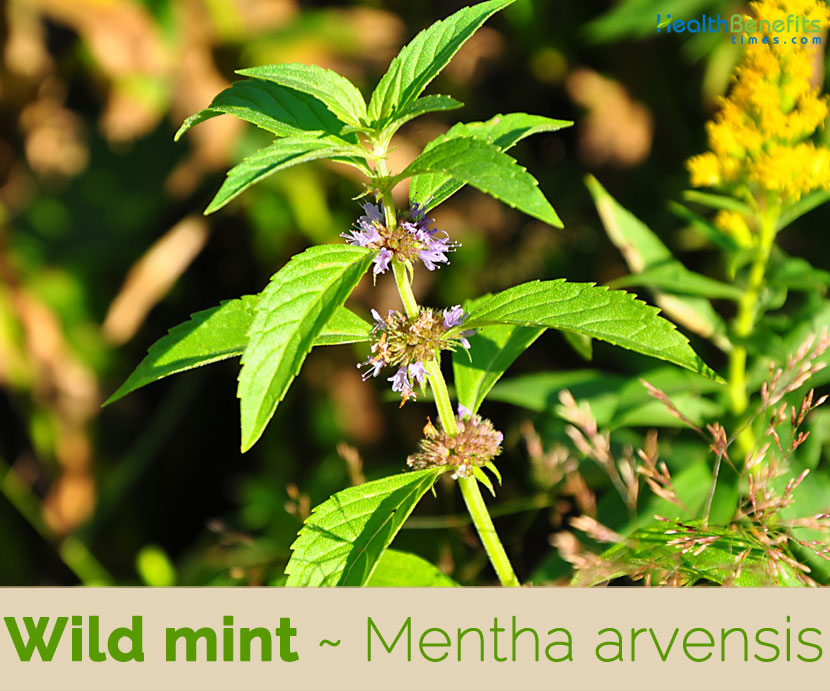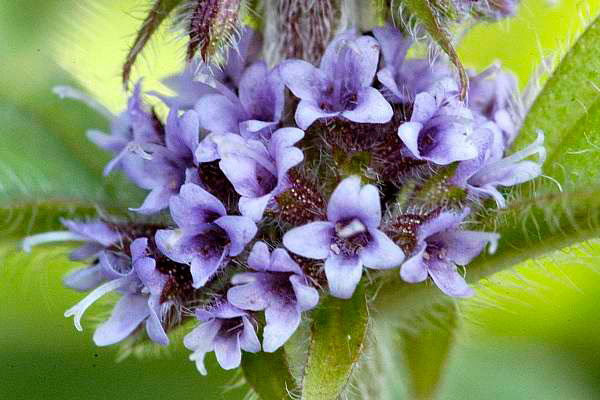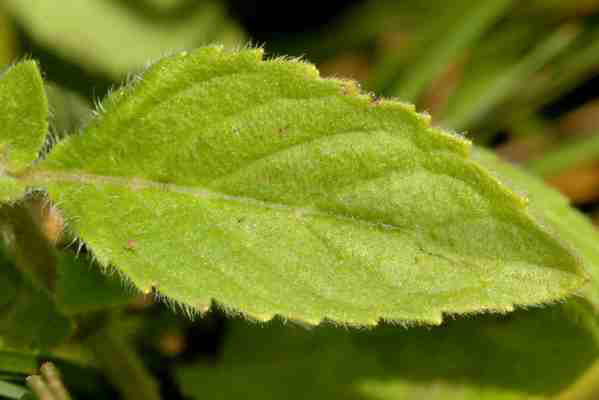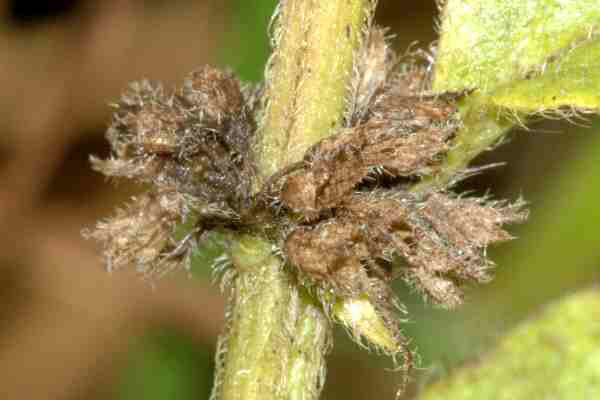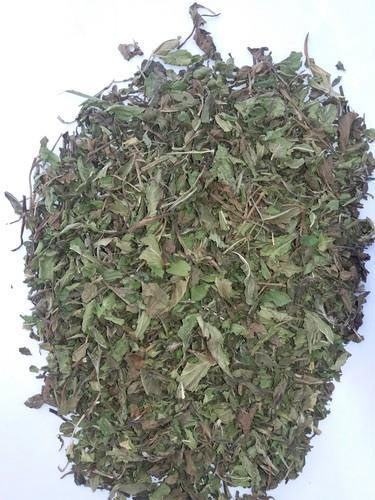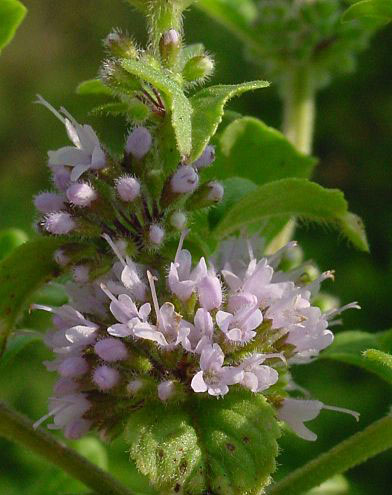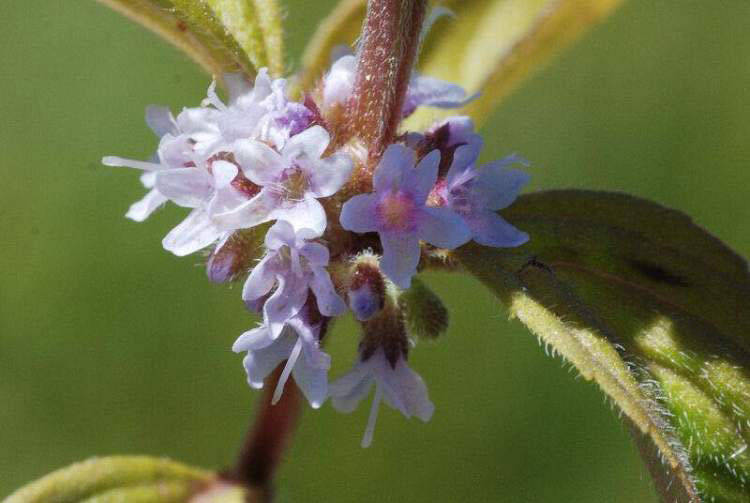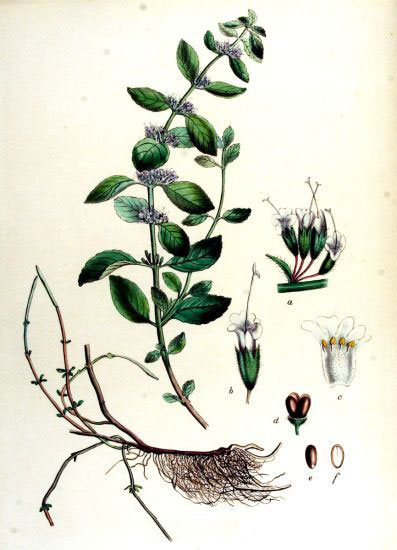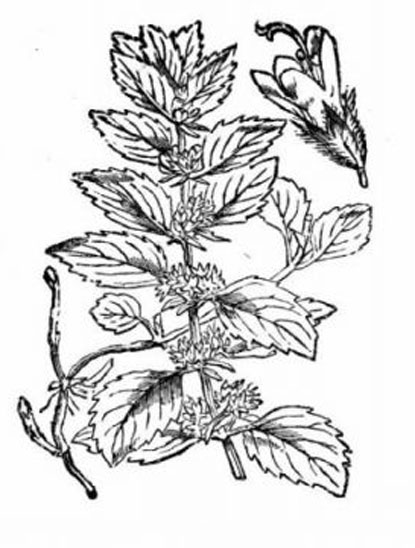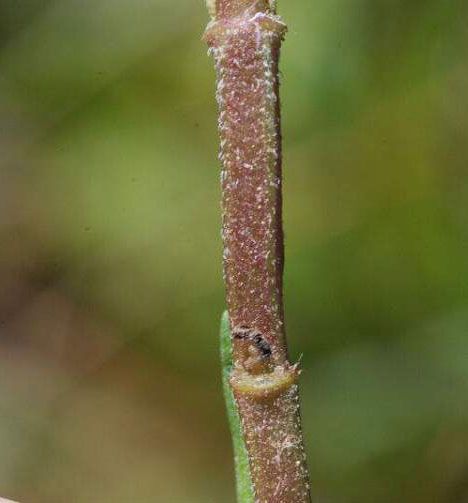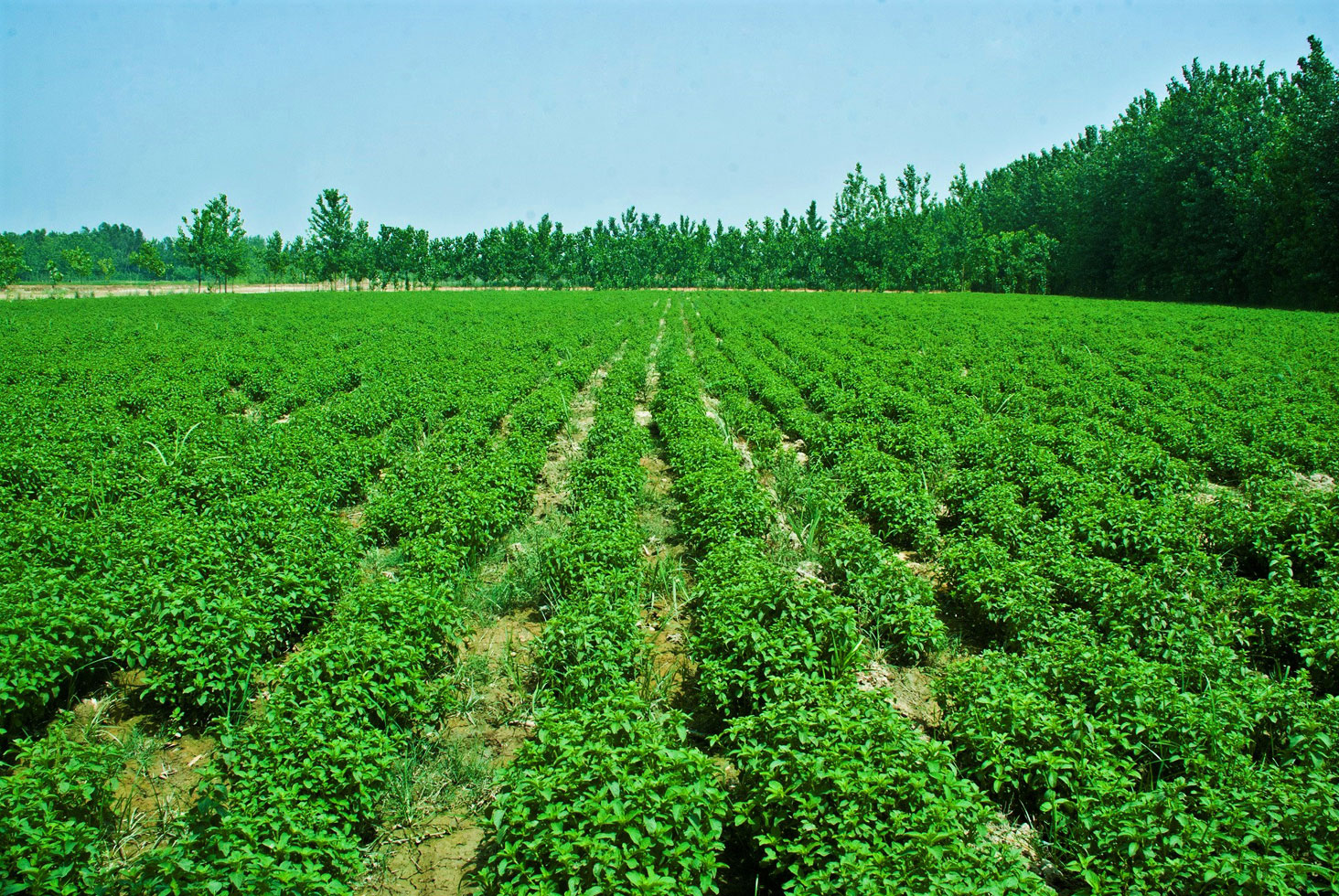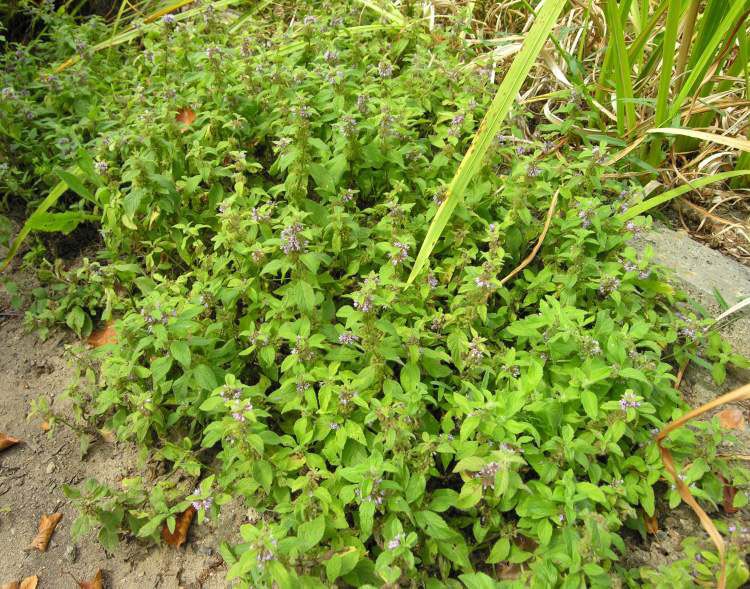| Wild mint Quick Facts | |
|---|---|
| Name: | Wild mint |
| Scientific Name: | Mentha arvensis |
| Origin | Temperate regions of central and western Asia and Europe, cultivated in tropical regions of Asia, and naturalized in North America and is found in all states of the United States |
| Shapes | 4 dry 1-seeded schizocarpous nut lets enclosed in the persistent calyx; nut lets ellipsoid, about 1 mm long |
| Taste | Pungent |
| Health benefits | Gastrointestinal Health, Cancer Treatment and Prevention, Bad Smells of breath, Nausea and indigestion, Overcome Allergies, Maintain healthy skin, Prevent the sore of the nipple |
|
Plant characteristics |
Life Form: Forb
Growth Habit: Herb Duration: Perennial Foliage Color: Green Fruit/Seed Color: Brown Bloom Color: White, purple Boom Time: July-September Active Growth Period: Spring Growth Form: Single stem Growth Rate: Moderate |
Health benefits of Wild mint
Wild mint has long been used as a folk remedy for a broad range of ailments, including gastrointestinal problems and sore throats. Wild mint has been found to have powerful antimicrobial, antifungal and antioxidative effects. Listed below are few of the popular health benefits of using wild Mint
1. Antioxidants
Several researchers have discovered wild mint to have high antioxidant activity that leads to other health benefits. One research found particularly high antioxidant activity and free-radical scavenging ability in methanol extract of wild mint. Another study examined ethanol extract of Mentha longifolia and found the extract to protect against crucial types of cell damage. Wild mint was also found to exhibit markedly high free-radical scavenging activity in an assessment of nine varieties of Mentha species.(1), (2), (3)
2. Gastrointestinal Health
Wild mint is extensively used for its digestive benefits, mainly for diarrheal disorders. In one study, Mentha longifolia essential oil was found to inhibit diarrhea in rats by preventing intestinal hyperactivity and hyper-secretion associated with the condition. Another study considered the applications of wild mint in hyperactive gut disorders, and it was found that crude Mentha longifolia extract inhibited spontaneous gut contractions due to its calcium-channel blocking activity. (4), (5)
3. Cancer Treatment and Prevention
Wild mint has also been studied at length for its cancer-fighting activity. One study assessed the anticancer activity of the mint varietal, and found it to produce significant anti-mutagenic effects on mammalian cell lines. In another study, methanolic extracts of Mentha longifolia and Ocimum basilicum produced remarkable cytotoxic effects on human breast cancer cell lines. Methanolic extract of Wild mint, in addition to extracts of two other mint species, was found to have a significant anti-proliferative effect against human cancer cells.(6), (7), (8)
4. Nausea and indigestion
Wild Mint in capsule form or prepared as a tea to relieve nausea and indigestion. It has the potential to the digestive system and relieves stomach cramps. It has a mild anesthetic effect so as to relieve pain in the stomach. The Journal of Advanced Nursing showed that the mint leaves as an anti-nausea drug post-surgery. It can also be used as a nausea reliever and menstrual cramps.
5. Overcoming Allergies
Wild Mint leaves are excellent in controlling allergic skin. For those who often suffer from skin allergies, you should try to add a mint leaf on the food they consume. This is because the mint has a substance that can help in controlling and eliminating the fungus and bad bacteria. Given that control allergies that will attack the skin becomes more controllable.
6. Maintain healthy skin
Wild mint leaves consists of vitamins E and D that are very good for maintaining healthy skin. In this case, used to help renew dead skin or skin that is not good. Besides the benefits of salicylic acid, which is very useful in the process of replacement of skin cells that have been damaged? So that the skin is growing afterward become healthier and appear fresh.
7. Prevent the sore of the nipple
ASI can provide significant benefits for infants and the elderly, but also can cause pain and nipple’s sore. In the International Breastfeeding Journal suggests lane ways consume mint water to prevent cracking of the nipple and nipple pain at first lactating mothers.
8. Bad Smells of breath
Fresh mint flavor makes it ideal to relieve bad Smells of breath odors. Mint tea made from fresh mint leaves or dried effectively get rid of bacteria that cause bad smells of breath. Mint will also keep the mouth moist by stimulating saliva production.
Traditional uses and benefits of Wild mint
- Five parts of the plant are used to control phlegm, help menstrual blood to descend, strengthen the kidneys, treat asthma, for liver and spleen diseases, and for inflammation of the joints.
- When the whole plant is dried, prevents thirst and fevers, aids digestion and promotes urination.
- Plant is used in making medicines to treat gas disorders, distended and bloated stomach, fevers, and muscle twitches.
- It can also be boiled and taken to cure stomachaches.
- Liquid obtained from leaves can be mixed with honey and licked to cure loose bowels.
- They can be boiled and taken to cure inflammation and aching joints, sore throat, and coughing.
- Boiled with dried ginger, they are used to treat colds.
- Crushed young leaves are used as an inhaler and to treat a dazed dizzy feeling, and also to clear the brain.
- Liquid from the leaf is rubbed on like an ointment to relieve aching eyes.
- Liquid from distilling them can be given to cure stomachaches in children and to treat hypertension.
- They can be chewed and pressed onto a cat’s bite to disinfect it.
- Adding leaves to an anti-nausea medicine will speed its action.
- Corn mint, like many other members of this genus, is often used as a domestic herbal remedy, being valued especially for its antiseptic properties and its beneficial effect on the digestion.
- Whole plant is anaesthetic, anti-phlogistic, antispasmodic, antiseptic, aromatic, carminative, diaphoretic, emmenogogue, galactofuge, refrigerant, stimulant and stomachic.
- Tea made from the leaves has traditionally been used in the treatment of fevers, headaches, digestive disorders and various minor ailments.
- Leaves are a classical remedy for stomach cancer.
- Leaves are harvested as the plant comes into flower and can be dried for later use
- Essential oil in the leaves is antiseptic, though it is toxic in large doses.
- In Ayurveda, Pudina is considered as appetizer and useful in gastric troubles.
- Wild mint was traditionally used to treat flatulence, digestive problems, gall bladder problems and coughs in Europe.
- The Aztecs used it for similar purposes and also to induce sweating and cure insomnia.
- Oil was extracted and rubbed into the skin for aches and pains.
- Regular consumption helps you to get rid of toxins from the body.
- It relaxes the muscles of the digestive tract, eases the gas passage and relieves Abdominal Pain.
- It reduces cramps and Indigestion.
- Mint leaves builds up the healthy immunity and keeps the body free from Infections and Inflammation.
- Fresh mint leaves aid for bad breath and cures tooth decay and used as a mouth freshener.
- It is best used for acne and cures other skin problems. Its paste removes blackheads, dark circles and pimples.
- Paste has skin lightening properties and gets rid of dry skin.
- It decreases the hunger, increases the sense of fullness and satisfaction after having meal.
- Mint tea and chutney encourages the digestive enzymes and promotes the fat burning process.
- It consists of phytochemicals called perillyl alcohol that helps to fight different types of Cancer.
- It is an effective cure for the expecting mothers and relieves nausea, indigestion and vomiting that occurs during morning sickness.
- Chew and smell the fresh leaves daily morning to get relief from the morning sickness.
- It purifies the blood and relieves the muscle cramps.
- Mint eases the pain associated with menses and calms the uterus.
- It is consider a golden key to prevent Allergy and Hay Fever.
- It eases the problem of Cold and Cough.
- Inhale it through a vaporizer to clear respiratory tract and to relieve respiratory inflammation.
- It can also be used to reduce toothaches and swellings of gum.
- Oil extraction of these leaves is used in the treatments of insomnia and nervous tension.
Ayurvedic Health benefits of Wild mint
- Arthritis: Heat some fresh leaves of Mint on low flame. Put it over the affected muscle or joint when warm.
- Acid Reflux: Chew Mint leaves after every meal.
- Dark Circles: Crush some Mint leaves. Apply on the dark areas around the Eyes for 15-20 minutes and rinse. Repeat thrice a week.
- Eczema: Take fresh Mint leaves. Crush them. Squeeze the crushed leaves to extract its juice. Apply it over the affected area 2 to 3 times a day. Leave it to dry and wash with normal water.
- Blemishes: Take fresh Mint leaves. Extract the juice. Apply on the face. Apply again when dries. Wash with cold water. Regular use gives you the desired result.
- Gastric Catarrh: Take fresh Mint juice daily to cure Gastric Catarrh.
- Menstrual Disorders: Mix fresh Mint leaves juice with Honey in equal quantity. Consume it 30 minutes after meals twice a day.
- Strangury: Prepare tincture of Mint Leaves. Take 2 teaspoons once a day.
- Body Lice: Scrub the young leaves of the plant on the affected area. It will give you relief from itching.
- Hyper pigmentation: Make a paste of mint leaves. Apply it over the affected area and wash after 15 minutes.
- Blocked Nose: Suck fresh 4 to 5 leaves of Mint. OR: Have one cup tea of Mint leaves twice or thrice a day. OR: Boil 5 to 10 leaves of Mint in a bowl of water. Take vapor.
- Altitude Sickness: Make decoction of the dried leaves of Mint. Have a cup once a day.
- Peeling Skin: Crush fresh Mint leaves. Squeeze the juice. Apply over affected parts before going to bed. Rinse in the morning.
- Skin Diseases: Crush Mint leaves to make paste. Apply it over infected areas.
- Body Odor: Add 5 to 6 drops of Mint extract and a half teaspoon of Rose Water in your bathing water. It gives you fresh and odorless day.
- Stomach problems: Use a teaspoon of dried, or a small handful of fresh leaves for each cup of tea. Boil a handful of Mint leaves in a cup of water. Drink the tasty and healthy tea for Stomach Problems
- Facial Neuralgia: Take Mint Oil. Put 4 to 5 drops in boiling water. Inhale the vapor.
- Cold: Make an herbal tea by boiling Mint leaves in water. Drink hot.
- Toothache: Prepare a decoction of Mint leaves in two glasses of water. Strain. Take 1/4th glass 2-3 times a day.
- Gum Disease: Boil some leaves in water for 5-10 minutes. Use as a mouth wash.
- Nausea: Apply the crushed Mint leaves at nostrils of the patient.
- Insect Bites: Apply the leaf juice on the affected area. OR: Rub the crushed leaves on the affected part.
- Sallow Skin: Take fresh Mint leaves. Crush them. Apply over affected areas. Let it dry. Rinse with normal water. OR: Dry Mint leaves. Crush to make powder. Take a teaspoon of powder. Add Yogurt or Rose Water to make paste. Apply over affected parts. Let it dry. Rinse with normal water. It gives you light complexion and glow.
- Bad Breathe: Chew 3-4 leaves of Mint daily. OR: Take dried powdered Mint leaves and use to clean your teeth. Regular application is also useful for strengthening the gums
- Headache: Grind some fresh Mint leaves and apply the paste on your forehead. It is useful in headaches caused by depression or heat.
- Tonsillitis: Boil a handful of Mint leaves in a cup of water till is reduced to half. Add some Honey for taste and drink warm. Use this herbal remedy thrice a day for a few days.
- Belching: Crush a handful of Mint leaves. Add it to a glass of water. Drink daily for 15 days.
- Morning Sickness: Boil a handful of Mint leaves in some water and inhale the fumes to get relief.
- Dental Abscesses: You can use either Fresh Leaves of Mint or its Essential oil. Apply it on the affected areas. It contains antiseptic and anti-inflammatory properties. Repeat the process 2 to 3 times in a day.
- Heat Exhaustion: Extract the juice of Mint leaves by grinding and squeezing them. Pour 3-4 tablespoons of the juice in one glass of water and add a pinch of sugar in it. Drink it once a day.
- Scarlet Fever: Add 4-5 crushed Mint leaves in one cup of water. Boil it. Simmer for 10 minutes. Strain and drink it twice daily.
- Anorexia: Grind Mint leaves to extract out the juice. Consume a glass of it regularly. It will help to cure Anorexia.
- Acne scars: Apply fresh juice of Mint on the affected areas. Leave it for half an hour. It is rich in nutrients and has anti-inflammatory effects. It will help in treating Acne, as well as Scars left after Acne. Apply daily to get good results.
- PCOS: Boil 4 to 5 fresh Mint leaves in water and have this tea every day.
- Cold: Prepare a decoction of Cockelburr Fruit, Magnolia Flower, Angelica Root and Mint Leaves. (Caution: Drink once a day only for 3 days. Over dosage may lead to toxicity.)
- Insomnia: Take equal quantities of Dill, Mint and Fennel. Soak 1 tsp. in 1/2 cup boiling water. Take with Honey at bed time.
- Indigestion: Take combined mixture of White poplar, Balmony, Aniseed and Golden Seal for treatment of Indigestion
- Constipation: Grind 3 leaf buds of Acacia Concinna with 1/4 tsp. Tamarind paste, 2 tsp. Mint leaves and 2 tsp. of Coriander leaves. Add Asafetida, Black Pepper and Salt to taste. Mix it in cooked Rice and eat.
- Asthma: Take half cup juice of Adhatoda Vasica leaves, Mint leaves, Ginger and Lime. Add 1 cup Carom. Mix well. Leave it under the sun to dry. Grind to make a powder. Preserve it in a container. Take quarter spoon with Honey twice a day for a month.
- Blackheads: Mix Turmeric with Mint juice. Apply over the affected areas. Leave it for 20-25 minutes. Wash it off with warm water
- Belching: Add 2 tsp. of Blackberry powder and 2 tsp. of Mint in a cup of boiling water. Let it cool. Drink 2-3 times a day.
- Cholera: Grind the root and bark of Sodom to make a fine powder. Add some Ginger juice and Black Pepper. Mix properly to make a thick paste. Make pea sized pills of it. Make a decoction of Cardamom and Mint leaves. Take 1 pill with the decoction after every 2 hours. Use it for 5 days
- Indigestion: Take 100 gram Mint, 100 gram Coriander, 2 or 3 Onions, One Tomato and 5 to 6 Chili. Put them in a grinder. Grind them properly. Have it with your food. (Attention: This chutney is very beneficial for digestive system. Take it whole life.)
- Acid Reflux: Take out the juice of Tomato. Put one teaspoon Ginger Juice and one teaspoon Field Mint juice in half cup of Tomato juice. Drink once a day.
- Sinusitis: Take 10 Cloves, 10 Field Mint leaves and 10 Eucalyptus leaves. Boil in one liter water. Inhale the steam twice a day. (Attention: You may take steam of simple water, if these ingredients are not available.)
- Vomiting: Take one teaspoon Juice of each of Basil leaves, Field Mint and Aniseed. Mix juices and have it.
- Nerve Disorders: Take equal quantity of Valerian Root, Field Mint Leaves, Chamomile Flowers, Caraway Seeds and Basil Leaves. Put all in a jar. Grind. Add one teaspoon in one cup hot water. Keep for 20 to 25 minutes and drink twice a day.
- Indigestion: Mix equal quantities of Aniseed, Caraway, Dill and Fennel. Add dried Mint leaves in it. Steep 1 tsp. in 1/2 cup of boiling water. Take 30 Minutes before a meal.
- Acid Reflux: Prepare a tea by adding Mint leaves and Licorice bark. Drink once a day.
- Flatulence: Take 4 leaves of both Mint and Peppermint. Add half tsp. seeds of each Aniseed and Caraway. Prepare tea with it. Drink once a day.
- Vomiting: Take Lime juice, Mint juice in equal quantity and add Ginger juice in half quantity.
- Age Spot: Grind 15 Mint leaves. Now mash a Banana. Mix both. Apply on the face. Let it dry and wash with fresh water
- Vomiting: Mix half tsp. each of Lime juice and Mint juice. Add quarter tsp. Ginger juice with 1 tsp. Honey in it. Have it once a day. It helps in stopping the Vomiting.
- Acne: Take equal quantity of the leaves of Mint and Basil. Crush them to make a paste. Add some Lime juice in it. Mix and apply on the Pimples.
- Acne: Take 1 teaspoon Basil Leaves Powder, 1 teaspoon Mint Leaves Juice and 1 teaspoon Lemon Juice. Mix them. Apply on the face till it dries. Wash with cold water.
- Stomach ache: Take One teaspoon each of Mint juice and lime juice. Add Ginger and one pinch of black salt to taste. Drink.
- Stomachache: Take equal quantity of Dry Ginger, Black Pepper, Roasted Cumin Seeds, Dry Mint Leaves, Coriander, Asafetida, Garlic and Rock Salt and make powder. Have one tablespoon after meals.
- Acne: Crush fresh leaves of Coriander and Mint together. Apply this paste on Acne. Let the paste dry and wash with water.
- Obesity: Boil some Mint leaves in water. Cool. Add salt and crushed Black Pepper in it. Drink thrice a day.
- Indigestion: Take half teaspoon juice of each Mint leaves and Lemon. Mix and take it with Honey.
- Flatulence: Take equal quantity of powdered Black Pepper, Powdered Ginger, Powdered Mint Leaves and Powdered Coriander Seeds. Grind them to make powder. Have half teaspoon with lukewarm water twice a day.
- Phlegm: Take the leaves of Mint and Eucalyptus in equal quantity. Boil in 2 liters of water. Remove from heat and take steam.
- Baldness: Mix half cup of Yogurt with One tablespoon each of Olive Oil and powdered Mint. Apply evenly on the scalp at least 1 hour before hair wash. It gives a new shine to your hair and controls hair fall.
- Indigestion: Boil 7-8 leaves of Basil and Mint. Strain and drink this water to get relief from Indigestion.
- Memory Enhancer: Boil Mint leaves for 8 minutes. Add 2 ml Black Cumin oil in it. Use it regularly for 1 month.
- Allergy: Take 10 to 12 leaves of Mint each and Basil. Boil in half liter of water. Steam for 5 minutes thrice a week.
- Allergy: If you are allergic to dust, Crush 5 Mint leaves and put in a cup of Yogurt. Take it once a day.
- Hoarseness: Take 2 Cardamom, 1/2 teaspoon Fennel, 10 Mint Leaves and quarter teaspoon Lemon juice Boil first three ingredients in a glass of water. Add Lemon juice and one teaspoon of Honey. Have 2 tablespoons after every 4 hours.
- Hoarseness: Take 2 fresh leaves of Mint and a small piece of Ginger. Chew them together once a day.
- Yellow teeth: Take 1 tablespoon Almond Peels Powdered, 1 tablespoon Dried Mint Leaves Powdered and ½ tablespoon Common Salt. Mix all ingredients. Keep in a bottle. Use it daily to rub your teeth once a day before brush.
- Indigestion: Boil some Alfalfa leaves or Seeds along with Mint leaves in a cup of water. Drink Luke warm after every meal.
- Acid reflux: Put some Alfalfa leaves in a cup of boiling water. Add few Mint Leaves. Consume as a tea after every meal.
- Blood impurity: Combine equal parts of Alfalfa Leaves, Mint, Stinging Nettle Leaves and Dandelion Leaves. Put One tablespoon of herbs in a cup of water and boil to make a tea. Drink the nourishing blend for Blood Purification.
- Belching: Take 10 leaves of mint, 5 gram Ginger and 5 gram Fennel Seeds. Put all ingredients in a glass of water. Boil on low flame. Strain. Have it slowly twice a day after meal.
- Rheumatoid Arthritis: Chop the fresh Mint leaves and squeeze the juice. Mix a few drops of Eucalyptus oil. Massage gently on the painful parts.
- Stomach ache: Take fresh Mint leaves. Crush. Extract the juice. Add half teaspoon Lemon juice in one teaspoon of Mint juice. Have it twice a day. OR: Prepare decoction from Mint leaves. Drink a cup 3 times a day.
- Lung Disease: Take One tablespoon each of Mint leaf Juice and Carrot juice. Add some Honey and take on an empty stomach in the morning for a few weeks. It strengthens the Lungs.
- Piles: Take a decoction of Mint, Honey, Ginger and Sweet Lime for a cooling effect in Piles and to stay away from toxins.
- Dark Circles: Chop a handful of Mint leaves and add juice of 1/2 Lemon in it. Apply on the Dark areas around your eyes and leave it on for 15-20 minutes. Wash off gently.
- Morning Sickness: Take One tablespoon each Lemon juice, Mint leaf juice and Honey. Add half tablespoon chopped Ginger. Mix well and drink twice a day.
- Eczema: Squeeze and crush Mint leaves to get juice. Add Sandalwood powder. Mix it well to make a paste. Apply it over the affected area and let it dry. Wash with normal water. Repeat as long as the problem persists.
- Obesity: Take 1 to 2 tablespoons of grated Ginger, 1 sliced Cucumber, 1 sliced Lemon and 1/2 cup of fresh Mint leaves. Take 5 to 6 cups of water. Add all the above herbs in it. Stir well. Keep it in the refrigerator for a night. Drink it next day. Have it 2 to 3 times a day. (Note: Make a fresh infusion for every day.)
- Jaundice: Take 1 tablespoon of Lemon Juice, 1 tablespoon of Mint juice and 1 tablespoon of Ginger juice. Add 1/2 teaspoon of Honey to all 3 juices. Mix them well. Take 1 table spoon of this combo 2 times in a day. This will help to deal with Jaundice.
- Immunity booster: Add 2 cutted Kiwi Fruits with 1 Lemon, some leaves of Parsley, 2 to 3 leaves of Mint and a half teaspoon of Honey into a half glass of water, Blend all together. Drink this mixture daily. This healthy juice will enhance your immunity.
- Obesity: Blend 2 leaves of Mint, some fresh leaves of Parsley, a half teaspoon of Honey, half Lemon and 2 Kiwi Fruits with a glass of fresh water. Daily intake of this juice will help you in reducing your weight.
- Leucoderma: Take a hand full of Neem leaves and Mint leaves. Add 2 big spoons of Aloe Vera gel to the mixture. Apply on the affected area and leave it for 20 minutes. Repeat the process 2 times in a day.
- Wrinkles: Extract the juices of 4-5 fresh Mint leaves, half teaspoon of Rose Water and 4-5 pieces of Cucumber. Soak the cotton ball in the juice and apply on the wrinkles. Leave it for 15 minutes. Wash it with warm water.
Culinary uses
- Leaves can be consumed raw or cooked.
- A reasonably strong minty flavor with a slight bitterness, they are used as a flavoring in salads or cooked foods.
- Herb tea is made from the fresh or dried leaves.
- An essential oil from the plant is used as a flavoring in sweets and beverages.
- Leaves contain about 0.2% essential oil.
Other Facts
- The solid obtained from their oil is used as an additive in toothpaste and soap in order to enhance their properties.
- Plant is used as an insect repellent.
- Rats and mice intensely dislike the smell of mint.
- Plant was therefore used in homes as a strewing herb and has also been spread in granaries to keep the rodents off the grain.
- Leaves also repel various insects.
- An essential oil is obtained from the plant.
- The sub-species M. arvensis piperascens produces the best oil, which can be used as a substitute for, or adulterant of, peppermint oil.
- Whole plant has a very strong, almost oppressive, smell of mint.
- Flowers are very attractive to bees and butterflies.
- Mint extracts and menthol-related chemicals are used in food, drinks, cough medicines, creams and cigarettes.
- Mentha arvensis oil is used in soaps, perfumes and other cosmetic products.
- It is also used as a fragrance element in detergents.
- This oil is used in aromatherapy.
- Leaves as well as the oil of these plants are used in toothpastes and mouthwashes
Precautions
- Large quantities of some members of this genus, especially when taken in the form of the extracted essential oil, can cause abortions so some caution is advised.
- Its oil may be unsafe for children especially when applied around the nose.
- Do not use its oil if have liver disease, gall stone, bile.
- People with gastro esophageal reflux disease (GERD) do not use mint in an attempt to soothe digestive problems if the symptoms associated with gastro esophageal reflux disease (GERD); mint can worsen this condition.
- For people with a history of gallstones, use mint carefully and consult a physician beforehand.
- On baby, do not apply mint oil to his face, because it can lead to seizures that inhibit breathing.
- Pregnant or breastfeeding should avoid the consumption of mint tea because consume it can cause miscarriage.
- Mint leaves if taken in large doses, it can be toxic. Pure menthol is toxic and should not be taken internally.
- Tea may be too strong to cause a burning sensation in the mouth.
- It can lower the glucose content in the blood. Caution is recommended when taking sugar lowering drug.
- It can lower blood pressure. Caution is advised when taking blood pressure lowering drugs as Yerba buena can strengthen its effects.
- Extended contact can cause skin irritation.
References:
https://davesgarden.com/guides/pf/go/55037/
https://www.itis.gov/servlet/SingleRpt/SingleRpt?search_topic=TSN&search_value=565302#null
https://npgsweb.ars-grin.gov/gringlobal/taxonomydetail.aspx?id=24069
https://pfaf.org/user/Plant.aspx?LatinName=Mentha+arvensis
http://www.floracatalana.net/mentha-arvensis-l-subsp-arvensis
https://plants.usda.gov/core/profile?symbol=MEAR4
http://linnet.geog.ubc.ca/Atlas/Atlas.aspx?sciname=Mentha%20arvensis
https://www.inhs.illinois.edu/data/plantdb/detail/1666
http://swbiodiversity.org/seinet/taxa/index.php?taxon=659&clid=4978
https://species.wikimedia.org/wiki/Mentha_arvensis
https://en.wikipedia.org/wiki/Mentha_arvensis
https://gd.eppo.int/taxon/MENAR


